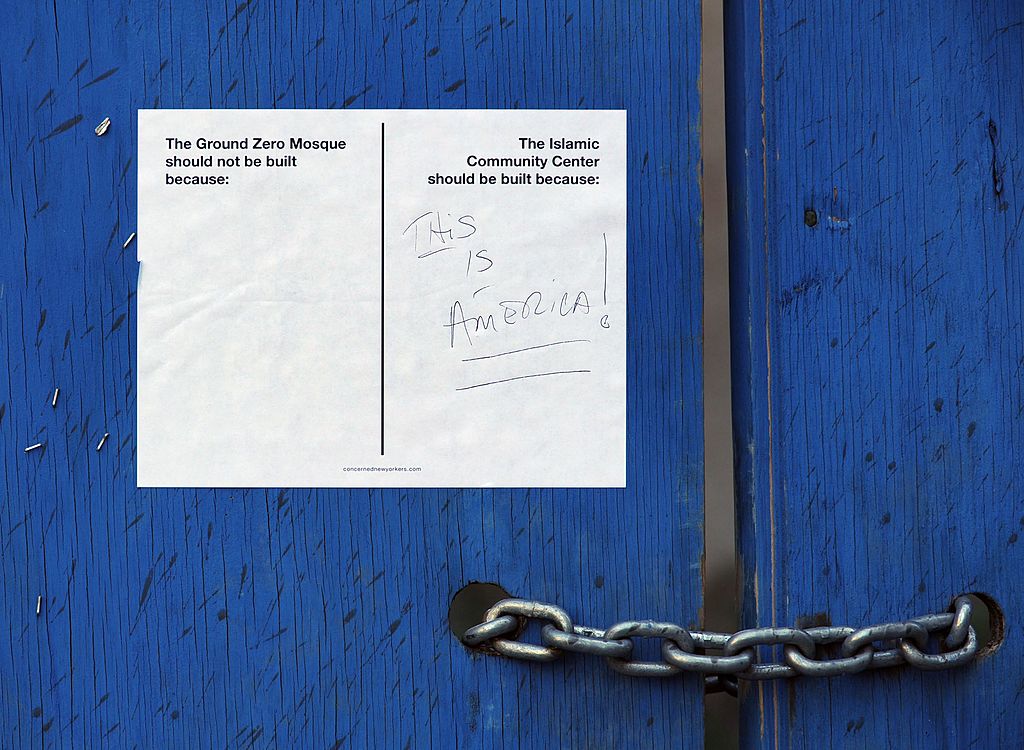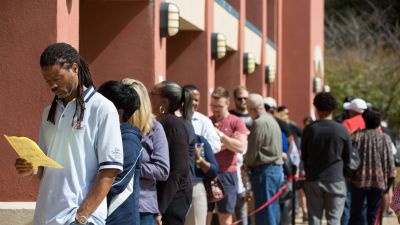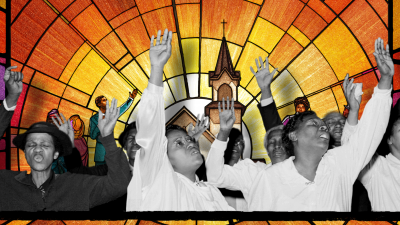
Ann Podina from Long Island attends a rally in opposition to the controversial proposed mosque located near Ground Zero during the 9/11 anniversary remembrance ceremony in New York on Sept. 11, 2010. (Photo by Carol Guzy/The Washington Post via Getty Images)
In the annals of American democracy, hardly anything of lasting consequence ever took place at a meeting of one of New York City’s community boards. These panels of volunteers, many of them appointed by local political bosses, hold no binding power and are only an advisory voice on issues like land use, construction and zoning.
There is, however, one red-letter date associated with the community board that covered the southern tip of Manhattan, and we are approaching its anniversary. May 25 is the seventh anniversary of Islamophobia in America. Not that the irrational fear and hatred of Muslims and Islam started then and there, but rather that the events helped coalesce a loose alliance of bigots and opportunists into a political movement, the same movement that ultimately elected Donald Trump as president.
On that spring evening in 2010, the members of Community Board 1 heard testimony and cast their votes about a proposal that a former coat factory be turned into a Muslim community center that would include a prayer room. In a reference to the Golden Age of religious coexistence in Moorish Spain, the building would be called Cordoba House. Its leaders, Imam Feisal Abdul Rauf and his wife Daisy Khan, embodiments of moderate Islam and respected veterans of interfaith work, had consciously modeled their project on a Jewish Community Center on the Upper West Side.
Though the community board did endorse the plan by a vote of 29 to 1, with 10 abstentions, and though Cordoba House had the powerful support of Mayor Michael Bloomberg, it became apparent during a tempestuous four-and-a-half-hour hearing that the better angels had lost control of the narrative and the rhetoric. Because Cordoba House was going to be located two blocks from the World Trade Center site, in a building that had been slightly damaged by debris from one of the weaponized passenger jets, the project was already being reviled as an insult to the fallen of Sept. 11. Thereafter, in complete defiance of the facts, the proposed community center would be widely described as the “Ground Zero mosque.”

Signs offer people an opportunity to state their views to the controversial proposed mosque located near Ground Zero during the 9/11 anniversary remembrance ceremony in New York on Sept. 11, 2010. (Photo by Carol Guzy/The Washington Post via Getty Images )
As such, it attracted a Who’s Who of demagogues and extremists. It provided a focal point for anti-Muslim activism unlike any in nearly a decade since the Sept. 11 attacks. It sent the number of bias crimes against Muslims soaring. And, admittedly, the hateful cause benefited from three relatively recent acts of domestic terrorism — the fatal shooting of 13 soldiers at Foot Hood in November 2009 by a Muslim who was an Army psychiatrist; the failed use of an “underwear bomb” on a trans-Atlantic airliner bound for Detroit on Christmas Day; and the discovery of a car bomb, which had been set by a Pakistani-American citizen, in Times Square. That last incident occurred on May 1, just four days before the community board’s initial hearing on the Cordoba House proposal.
But if such events, and the memories in New York of Sept. 11’s mass murder, provided a plausible basis for individual grief and anger, those emotions were cunningly exploited by the orchestrators of the “Ground Zero mosque” calumny. First and foremost was Pamela Geller, the co-founder of a group called Stop the Islamicization of America (SIOA). She varied the lexicon to describe Cordoba House as the “mega mosque” and the “monster mosque,” but she was consistent in depicting it as a symbol of Muslim triumph over the Judeo-Christian West. After first mobilizing opposition at the time of the community board hearing, she went on hold a protest rally at Ground Zero on Sept. 11, 2010, and to co-produce a propaganda film entitled The Ground Zero Mosque: Second Wave of the 911 Attacks with Robert Spencer, her colleague in the SIOA. Both appeared on the Southern Poverty Law Center’s 2011 list of the “Anti-Muslim Inner Circle.”
In her campaign, Geller relied on many of the pillars of right-wing politics and media. She wrote regularly for Breitbart, where her articles and blog entries now run 28 screens long. The “alt-right” website’s founder, Andrew Breitbart, contributed a video-recorded speech for Geller’s Sep. 11 rally.
In New York, Rubert Murdoch’s tabloid The Post gave Geller a regular megaphone under headlines like “Mosque Madness at Ground Zero.” Geller and Spencer screened their putative documentary for the Conservative Political Action Committee convention.
From across the right-wing landscape, others followed her example. Robert Mercer, the reclusive billionaire who underwrote Breitbart, gave $1 million for a series of television ads against the “Ground Zero mosque.” Sarah Palin tweeted against it. Newt Gingrich declared, “Nazis don’t have a right to put up a sign next to the Holocaust Museum in Washington. We would never accept the Japanese putting up a site next to Pearl Harbor. There’s no reason for us to accept a mosque next to the World Trade Center.”
And a certain real estate developer and reality-TV star by the name of Donald J. Trump, who had shown his Islamophobic chops in the “birther” smear against President Obama, swaggered into the invented controversy. He offered to buy the would-be home of Cordoba House for $6 million, which he claimed was above market price, on the promise that Rauf, Khan, and their development partner not open their putative mosque anywhere near Ground Zero. Trump even took his sales pitch to David Letterman’s The Late Show in September 2010.
After hearing Trump bemoan the “insensitivity” of the Cordoba House plan, this very revealing exchange followed:
LETTERMAN: The notion — does this suggest that we are in fact officially at war with Muslims? Is that what this suggests?
TRUMP: Well, somebody knocked down the World Trade Center.
And a minute or so later came this:
LETTERMAN: What are you going to do?
TRUMP: Well, somebody’s blowing us up. I mean, somebody’s blowing up buildings, and somebody’s doing lots of bad stuff, David.
The reality is that even if Cordoba House really were to be a mosque and to be located at Ground Zero, that supposed affront would have been entirely true to the World Trade Center’s history. There had been a Muslim prayer room on the 17th floor of the south tower, frequented by everyone from international business people to construction workers to the cooks and waitstaff of the Windows on the World restaurant. During his tenure as Speaker of the House, that vocal foe of the “Ground Zero mosque,” Newt Gingrich, had helped Muslim staffers on Capitol Hill use a conference room for regular daily prayers.
Falsehood and hypocrisy, however, proved no match for a big lie, endlessly repeated. A Washington Post poll in September 2010 found that two-thirds of respondents opposed the Cordoba House plan. More importantly, the opposition ran far higher among Republicans than Democrats. A Quinnipiac poll of New Yorkers captured an even starker partisan divide. Only one-third of Democrats opposed the plan, while 90 percent of Republicans did.
Thus was a wedge issue born. Thus was the Republican Party suddenly defined by Islamophobia.
By now, almost 16 years after the Sept. 11 attacks, it is hard to remember how different things were under George W. Bush. As a candidate in 2000, Bush spoke out during one of the presidential debates against the profiling of Muslims by airport security; he went on to win a majority of Muslim voters that fall. Indeed, the strong currents of social conservatism and small-business ownership among American Muslims made them likely voters for the Republican Party. The most powerful Republican libertarian, Grover Norquist of Americans for Tax Reform, was (and still is) married to a Muslim.
Six days after Sept. 11, President Bush visited the Islamic Center mosque in Washington, offering an indelible sign to a shocked nation that al-Qaida’s attack would not be a pretext for retaliation against all Muslims. “The face of terror is not the true faith of Islam,” he said then. “That’s not what Islam is all about. Islam is peace. These terrorists don’t represent peace. They represent evil and war. Women who cover their heads in this country must feel comfortable going outside their homes. Moms who wear cover must be not intimidated in America. That’s not the America I know. That’s not the America I value.”
— President George W. Bush
Which brings us to the whopping paradox and to the most personal aspect of the damage wrought by the fabricated controversy around the “Ground Zero mosque.” According to FBI statistics, hate crimes against Muslims spiked from 12 in 2000 to 93 in 2001, most of those coming after Sept. 11. Yet, due in significant measure to Bush’s example of tolerance, the annual tally dropped to 33 in 2002 and remained below 50…until 2010, year of the “Ground Zero mosque.” Since then, the figure has never gone below 50, and it has risen each year since 2012, reaching 91 in 2015. (The FBI has not yet released in 2016 data.) A study of 20 states by the Center for the Study of Hate and Extremism at California State University in San Bernardino found a 78 percent increase in bias crimes against Muslims in 2015. Similarly, the Bridge Initiative at Georgetown University reported on an upsurge in bias incidents against Muslims during Trump’s presidential campaign.
Muslims have not been the only victims of the furies stirred by the “Ground Zero mosque” agitators. Attacks have also increased against Sikhs, who are sometimes mistaken for being Muslims because their religion requires men to wear beards and turbans. In the single most horrifying episode, a Wisconsin man with links to white-supremacist groups shot and killed six members of a Sikh temple in suburban Milwaukee in August 2012.
Almost needless to say, Cordoba House never was built. Recent reports have been contradictory — one saying the original developer was selling the property, another that a luxury building to be erected on the site will include a small museum about Muslim religion and culture. As an organization, Cordoba House does continue to promote interfaith work, especially the growing alliance between Jews and Muslims in America.
However reassuring, it would be historically erroneous to take a positive moral from the story of Cordoba House. Rather, the anniversary of that pivotal meeting of Community Board 1 attests to the potency of disinformation, the power of alt-right media, and the political salience of hatred. Visceral and vicious Islamophobia was not the unfortunate but in some ways understandable immediate reaction to a surprise attack that killed thousands of innocents. Rather, it was the product of a carefully engineered campaign of lies, a campaign that came together long after the initial shock of September 11 had worn off.
As the world was reminded again earlier this week in Manchester, one terrorist purporting to represent Islam can sow massive death, injury, and fear. At precisely such times, the task of civilized people is to refuse to exploit tragedy, to ensure that collective guilt is not inflicted on literally billions of innocent Muslims.
Once such a toxin is released, it is all but impossible to control and contain. Donald Trump’s putatively tolerant speech to Muslim leaders in Saudi Arabia made no conciliatory mention whatsoever of American Muslims, the proximate targets of his hate. To the peril of the nation and the world, the ultimate result of the “Ground Zero mosque” slander occupies 1600 Pennsylvania Avenue.




